The Task: Read All of the Commented Lines Under the Map Function in Chegg
Quick Overview
- To find the equation of a line you need a signal and a slope.
- The slope of the tangent line is the value of the derivative at the signal of tangency.
- The normal line is a line that is perpendicular to the tangent line and passes through the point of tangency.
Examples
Example 1
Suppose $$f(x) = x^three$$. Find the equation of the tangent line at the point where $$10 = ii$$.
Step 1
Discover the betoken of tangency.
Since $$x=ii$$, nosotros evaluate $$f(ii)$$.
$$ f(two) = 2^three = 8 $$
The point is $$(ii,eight)$$.
Step ii
Find the value of the derivative at $$x = 2$$.
$$ f'(x) = 3x^2\longrightarrow f'(ii) = 3(2^2) = 12 $$
The the gradient of the tangent line is $$grand = 12$$.
Step 3
Find the indicate-slope form of the line with slope $$chiliad = 12$$ through the point $$(2,viii)$$.
$$ \begin{align*} y - y_1 & = thou(x-x_1)\\[6pt] y - 8 & = 12(x-2) \cease{align*} $$
Answer
$$y - viii = 12(x-2)$$
For reference, hither is the graph of the role and the tangent line we just found.
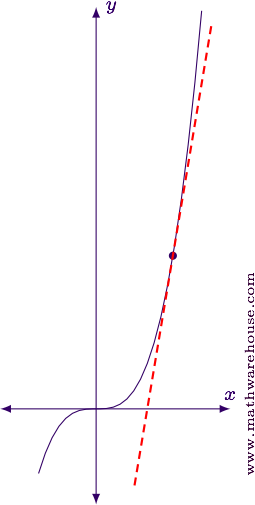
Example ii
Suppose $$f(x) = x^2 - x$$. Find the equation of the tangent line with slope $$m = -iii$$.
Footstep 1
Discover the derivative.
$$ f'(10) = 2x -i $$
Step ii
Observe the $$x$$-value where $$f'(x)$$ equals the gradient.
$$ \begin{marshal*} f'(x) & = 2x -1\\[6pt] -3 & = 2x -1\\[6pt] -two & = 2x\\[6pt] x & = -i \end{align*} $$
Stride 3
Observe the betoken on the function where $$ten = -1$$.
$$ f(-1) = (-1)^ii - (-1) = 1 + i = two $$
The signal is $$(-1, 2)$$.
Step 4
Find the equation of the line through the point $$(-1,two)$$ with gradient $$m=-3$$.
$$ \begin{align*} y -y_1 & = m(10-x_1)\\[6pt] y - 2 & = -iii(x - (-i))\\[6pt] y - 2 & = -3(x+1) \end{align*} $$
Answer
$$ y - 2 = -3(x+1) $$
For reference, here's the graph of the function and the tangent line nosotros just institute.
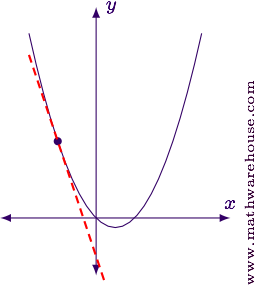
Tangent Lines to Implicit Curves
The process doesn't change when working with implicitly divers curves.
Example 3
Suppose $$x^2 + y^2 = 16$$. Observe the equation of the tangent line at $$x = ii$$ for $$y>0$$.
Step 1
Notice the $$y$$-value of the point of tangency.
$$ \begin{align*} \blueish{x^ii} + y^2 & = 16\\[6pt] \bluish{ii^ii} + y^ii & = 16\\[6pt] \blueish{iv} + y^2 & = 16\\[6pt] y^2 & = 12\\[6pt] y & = \pm\sqrt{12}\\[6pt] y & = \pm\sqrt{4\cdot 3}\\[6pt] y & = \pm2\sqrt 3 \end{align*} $$
Since the problem states nosotros are interested in $$y>0$$, nosotros use $$y = 2\sqrt 3$$.
The point of tangency is $$(2, 2\sqrt 3)$$.
Step 2
Find the equation for $$\frac{dy}{dx}$$.
Since the equation is implicitly divers, we utilise implicit differentiation.
$$ \begin{marshal*} 2x + 2y\,\frac{dy}{dx} & = 0\\[6pt] 2y\,\frac{dy}{dx} & = -2x\\[6pt] \frac{dy}{dx} & = -\frac{2x}{2y}\\[6pt] \frac{dy}{dx} & = -\frac x y \end{align*} $$
Step three
Notice the slope of the tangent line at the point of tangency.
At the point $$(2,2\sqrt three)$$, the gradient of the tangent line is
$$ \begin{align*} \frac{dy}{dx}\bigg|_{(\blue{2},\red{ii\sqrt iii})} & = -\frac {\bluish ii} {\red{ii\sqrt 3}}\\[6pt] & = -\frac 1 {\sqrt 3}\\[6pt] & = -\frac i {\sqrt iii}\cdot \blue{\frac{\sqrt 3}{\sqrt 3}}\\[6pt] & = -\frac{\sqrt three} three \end{align*} $$
The slope of the tangent line is $$m = -\frac{\sqrt iii} iii$$.
Pace iv
Find the equation of the tangent line through $$(2,2\sqrt 3)$$ with a slope of $$m=-\frac{\sqrt three} 3$$.
At the signal $$(2,2\sqrt three)$$, the gradient of the tangent line is
$$ \brainstorm{marshal*} y - y_1 & = one thousand(10-x_1)\\[6pt] y - 2\sqrt 3 & = -\frac{\sqrt 3} 3(x-2) \stop{marshal*} $$
Reply
The equation of the tangent line is $$y - 2\sqrt 3 = -\frac{\sqrt 3} 3(x-2)$$
For reference, the graph of the bend and the tangent line nosotros found is shown below.
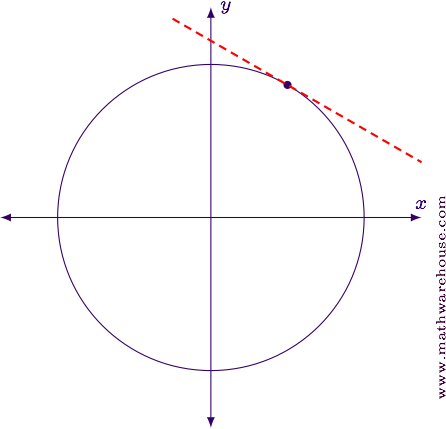
Normal Lines
Suppose we have a a tangent line to a function. The function and the tangent line intersect at the point of tangency. The line through that same bespeak that is perpendicular to the tangent line is called a normal line.
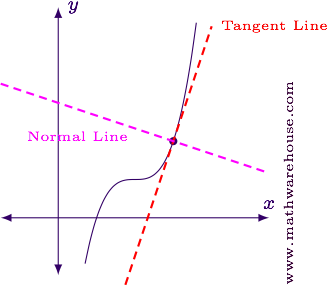
Recall that when two lines are perpendicular, their slopes are negative reciprocals. Since the slope of the tangent line is $$k = f'(x)$$, the slope of the normal line is $$m = -\frac 1 {f'(x)}$$.
Example iv
Suppose $$f(ten) = \cos x$$. Find the equation of the line that is normal to the function at $$x = \frac \pi 6$$.
Pace ane
Find the indicate on the function.
$$ f\left(\frac \pi 6\right) = \cos \frac \pi 6 = \frac{\sqrt 3} 2 $$
The betoken is $$\left(\frac \pi 6, \frac{\sqrt 3} 2\right)$$.
Pace two
Observe the value of the derivative at $$x = \frac \pi six$$.
$$ f'(ten) = -\sin x\longrightarrow f'\left(\frac \pi six\correct) = -\sin\frac\pi 6 = -\frac i 2 $$
The slope of the tangent line is $$yard = -\frac i 2$$. Since we are looking for the line that is perpendicular to the tangent line, we want to utilize $$m = 2$$.
Step 3
Find the equation of the line through the betoken $$\left(\frac \pi 6, \frac{\sqrt 3} ii\right)$$ with a slope of $$k =2$$.
$$ \brainstorm{align*} y -y_1 & = m(x-x_1)\\[6pt] y - \frac{\sqrt 3} two & = two\left(10 - \frac \pi vi\right) \end{align*} $$
Reply
The line normal to the function at $$x = \frac \pi 6$$ is $$y - \frac{\sqrt three} 2 = 2\left(x - \frac \pi 6\right)$$.
For reference, hither is the graph of the role and the normal line we constitute.
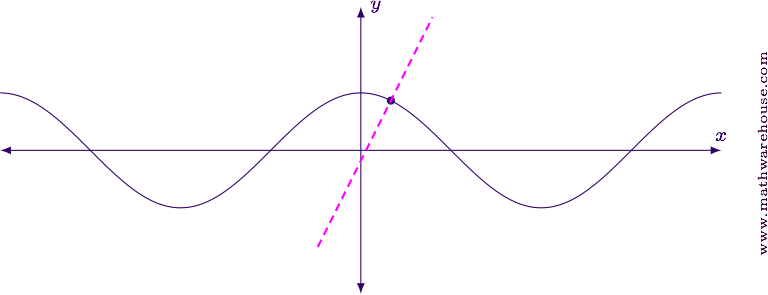
Proceed to Do Problems

Mistake : Delight Click on "Not a robot", and then endeavor downloading once more.
blanchardhomplever.blogspot.com
Source: https://www.mathwarehouse.com/calculus/derivatives/how-to-find-equations-of-tangent-lines.php
Posting Komentar untuk "The Task: Read All of the Commented Lines Under the Map Function in Chegg"